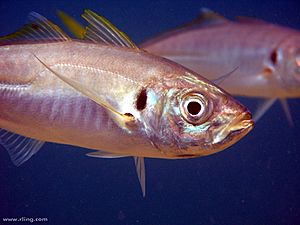Yellowtail horse mackerel facts for kids
Quick facts for kids Yellowtail horse mackerel |
|
|---|---|
 |
|
| Conservation status | |
| Scientific classification |
The yellowtail horse mackerel is a type of fish also called the yellowtail scad. It belongs to a group of fish known as "jacks" (part of the Carangidae family). You can find this fish swimming around Australia and New Zealand. They live in waters as deep as 500 meters (about 1,640 feet) and can grow up to 50 centimeters (nearly 20 inches) long.
Contents
What the Yellowtail Horse Mackerel Looks Like
The yellowtail horse mackerel looks a lot like another fish called the greenback horse mackerel. However, you can tell them apart by counting the small, hard scales along their side, called lateral line scutes. The yellowtail horse mackerel has 68 to 73 of these scales. The greenback horse mackerel has more, usually 76 to 82.
Where Yellowtail Horse Mackerel Live
Adult yellowtail horse mackerel live in waters near the coast and in areas where rivers meet the sea, called estuaries. They prefer water that is less than 150 meters (about 490 feet) deep. They also like warmer water, usually no colder than 13°C (55°F).
These fish often swim near the bottom or in the middle of the water. You won't usually see them near the surface. They like to swim together in large groups called schools. Adult fish are often found near rocky reefs just off the coast. Younger yellowtail horse mackerel prefer shallower areas with soft, muddy bottoms.
Fishing for Yellowtail Horse Mackerel
The yellowtail horse mackerel is a popular fish for both commercial fishing and people who fish for fun. These fish can live for a long time, up to 15 years, which is quite old for a fish of their size.
After being caught, yellowtail horse mackerel can be sold in many ways. You can find them fresh, smoked, or even canned. They are also sold frozen. When it comes to cooking, they can be fried, broiled, or baked. In New South Wales, Australia, between 300 and 500 tonnes of these fish have been caught each year since 1997.
See also
 In Spanish: Trachurus novaezelandiae para niños
In Spanish: Trachurus novaezelandiae para niños


